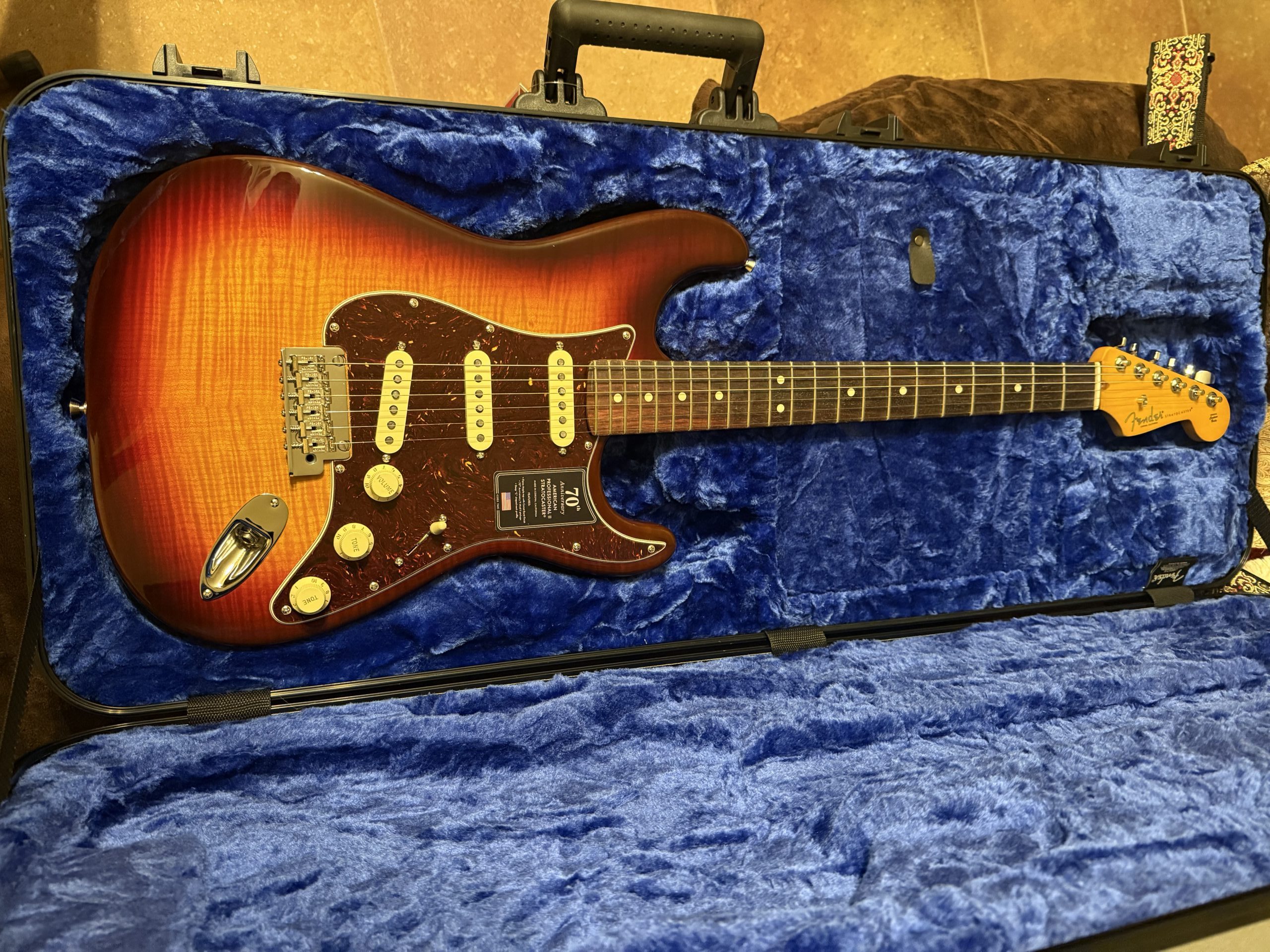Choosing your first—or next—electric guitar is a highly personal decision. What’s perfect for one player might not suit another. Recently, I caught the bug to hunt down a new Fender Stratocaster, so I thought I’d share some of the standout options I explored and what I ultimately decided to buy.
Should I get a New Stratocaster or Swap out Parts?
To start, this isn’t my first guitar—or my first Stratocaster—so my decision-making process might be different from someone buying their very first guitar. I began with a 2012 black American Strat fitted with Fat ‘50s pickups, which I really like. I also have an Olympic White Vintage Reissue ‘62 with a mint green pickguard and 57/62 pickups. I’ve always loved how that guitar looks—but I’ve never quite bonded with the feel or playability of its neck.
My dilemma was this: do I swap the neck, or trade the guitar in for something else entirely? After a trip to my local shop and getting a solid trade-in estimate, I decided to go the trade route. Fortunately, I was able to get most of my investment back on the guitar I was letting go.
In the end, I had a choice: spend less on a new neck and hope it delivered the feel I wanted—or trade in and start fresh with something that already fit my preferences. I chose to trade in and buy new. Honestly, once I started thinking about swapping the neck, I realized it could lead to more mods down the line—and I just didn’t want to go down that rabbit hole.
Where to Start on the Guitar Search?
I ruled out the Squier models early on, as I was looking for something beyond a starter guitar. That said, if you’re brand new to playing and working with a limited budget, a Squier Stratocaster is a solid entry point.
From there, I focused on models made in Japan, Mexico, and the USA. The Japanese-made Strats are impressive—the craftsmanship is top-notch and they have a unique character. The Mexican-made Stratocasters, now part of the Player II Series, offer excellent value for the price. If budget is still one of your top considerations, they’re a great place to start. In my case, I had a bit more to spend and found myself drawn to the tone and pickup quality of the American models. That’s where I ultimately decided to focus my search.
This video gives a good overview of the 3 manufacturing options.
Japanese Stratocaster
As mentioned earlier, the craftsmanship on the Japanese Stratocasters is excellent. The neck feels comfortable in the hand, and the overall attention to detail is impressive. If you like the tone these guitars produce, they’re definitely worth a closer look. Personally, I found the stock pickups a bit underwhelming—they lacked the character I was looking for. While this can certainly be addressed with pedals or amp tweaks, the pickups are designed to replicate a vintage sound that just didn’t quite hit the mark for me.
Mexican Player II Series
The Player II models offer strong value, though the workmanship felt a bit less refined compared to the higher-end lines. That said, I actually preferred the tone of the pickups—they had more bite and personality. Some fret edges were a little rough, but that’s something easily cleaned up with a file or some steel wool. One standout for me was the 70th Anniversary Edition in Nebula Noir. The finish is striking, and it comes equipped with Pure Vintage ’59 pickups, which sound fantastic. Plus, unlike most Player Series models, this one includes a gig bag.
American Professional II Series
To me, the American Professional II models feel like the spiritual successors to the old American Standards—but with meaningful upgrades. I really liked the Deep “C” neck, the rolled fingerboard edges, and the satin finish on the neck. The V-Mod II pickups sounded great, and all the guitars I tried played consistently well. Key features include the contoured neck heel, a push-pull tone knob to engage the neck pickup with the bridge, and a hard-shell case, which adds solid value.
American Ultra II Series
As you’d expect, the Ultra II series takes things up a notch. These guitars feature a modern D-shaped compound radius neck that plays fast and smooth, locking tuners for quick string changes, and a contoured neck heel that’s even more sculpted than the Professional II. Instead of a push-pull knob, it uses a push button to engage the neck and bridge pickups together. It’s a highly refined instrument loaded with premium appointments—and yes, it includes a hard-shell case as well.
Which One Did I Get?
For me, the Ultra II’s neck shape just didn’t feel familiar or comfortable, so I ruled it out early. That left me deciding between the Player II 70th Anniversary Nebula Noir and the Professional II models. While testing out the Professional II lineup, I happened to come across the 70th Anniversary Comet Burst version—and that ended up being the perfect fit. It had everything I was looking for: the Deep “C” neck profile, a contoured neck heel, locking tuners (a ~$150 upgrade on their own), and the upgraded 70th Anniversary V-Mod II pickups. Most importantly, it had the tone and feel I wanted.
Which Stratocaster is right for you? That really comes down to which features matter most. For me, these were the final three contenders—and I would’ve been happy with any of them. But the Fender Professional II 70th Anniversary Comet Burst ultimately checked all the right boxes.
My Final Top 3 Picks:
- Fender Professional II 70th Anniversary – Comet Burst
- Fender Professional II
- Fender Player II 70th Anniversary – Nebula Noir
It’s worth noting that my third pick—the Player II Nebula Noir—is arguably the best value of the three. It comes with Pure Vintage ’59 pickups and a gig bag, making it a great choice if price is a key factor. In my case, tone and features were the priority, so I went with the Comet Burst model. And if the 70th Anniversary versions are no longer available down the line, the standard Fender Professional II would be my next choice.
Key Decision Points Shopping for a Fender Stratocaster
Neck/Finger Board Choice
Stratocasters for the most part have 3 options all maple neck, maple with rosewood slab finger board, maple with Pao Ferro slab finger board.
Neck / Fingerboard Options
Most Stratocasters come with one of three common neck/fingerboard combinations:
- All maple neck and fretboard
- Maple neck with a rosewood fretboard slab
- Maple neck with a pau ferro fretboard slab
There’s a lot of debate over which fingerboard material is “best,” and if you’re curious, there are some great blind test videos on YouTube that can help you explore the tonal differences. But in my experience, it really comes down to what feels and looks best to you.e debate regarding which fingerboard is better the following YouTube video does a blind comparison so you can choose for yourself, should you choose to go down that rabbit hole.
Here’s a quick breakdown of what different models typically offer:
- American Models – Maple or Rosewood; satin-finished necks, with gloss varnish on maple fretboards
- Japanese Models – Maple or Rosewood; gloss finish on both the neck and maple fretboards
- Mexican Models – Maple or Pau Ferro; gloss finish on neck and maple fretboards
Occasionally, limited or special editions feature upgraded woods like ebony or true rosewood instead of pau ferro.
Tuners
Most Stratocasters come with either vintage-style or modern standard tuners. Both work well, and tuning stability isn’t usually an issue. Personally, since my guitar isn’t a vintage reissue, I was perfectly happy with the modern standard tuners.
Bridge Types
Strat bridges come in a few variations.
- Vintage-style models usually feature a 6-point synchronized tremolo, known for its classic feel but slightly trickier setup.
- Newer models (like the Player, Professional, and Ultra series) often feature a 2-point tremolo system, which is smoother to operate and comes with a snap-in tremolo bar instead of the traditional screw-in type.
Having used both, I prefer the 2-point bridge for its ease of use and modern feel.
Neck Joint Design
Lower-priced and vintage-inspired models typically use the traditional square neck joint, which can feel a bit bulky or uncomfortable when playing higher up the neck. Higher-end models like the Professional II and Ultra II include a sculpted neck heel, making upper fret access more comfortable and ergonomic.
Pickups
Everyone has a different opinion here—and after hours of research and testing, my conclusion is this: pickup choice is highly personal. There’s no universal “best” set.
That said, the pickups in higher-end models (like the American Professional and Ultra series) are excellent right out of the box. Unless you’re chasing a very specific tone, you probably won’t need to upgrade them. In lower-tier models, pickups can sound a bit less refined, but they’re perfectly fine for beginners or casual players—and you can always upgrade later if needed.
Cost
This is often the deciding factor. I was fortunate that budget wasn’t my main concern, but I know for many players it’s a big consideration.
For about $1,000 less, you can still get an amazing instrument—such as a Player II, Vintera II, or Traditional II—made in Mexico or Japan. These models offer excellent quality and tone for the price and are a great fit for most players.
If you’re just starting out and funds are tight, consider a Squier starter pack (not covered in this article, but a great entry point).
If you’ve got more to spend, I think the Professional II or Ultra II models are hard to beat in terms of quality and long-term value.
Consolidated Table of Fender Stratocaster Features:
| Feature | Fender Ultra II Strat | Fender Professional II Strat | Fender Player II Strat | Fender Vintera II Strat | Fender Made in Japan Strat |
|---|---|---|---|---|---|
| Body Wood | Alder or Ash (depends on finish) | Alder | Alder | Alder or Ash (depending on model) | Basswood or Alder (depends on series) |
| Neck Profile | Modern “D” | Deep “C” | Modern “C” | Mid-’60s “C”, “U”, or “Soft V” | Modern “C” or Vintage “U” (varies by model) |
| Fingerboard Radius | 10″–14″ compound | 9.5″ | 9.5″ | 7.25″ or 9.5″ | 9.5″ (Hybrid II) or 7.25″ (Traditional II) |
| Frets | 22 Medium Jumbo | 22 Narrow Tall | 22 Medium Jumbo | 21 Vintage or Medium Jumbo | 21 or 22 (Medium Jumbo common) |
| Pickups | Ultra Noiseless (Vintage/Hot Strat) | V-Mod II Single-Coils | Player Series Alnico 5 | Vintage-style ’60s/’50s or ’70s single-coils | Hybrid II Custom Vintage or Traditional ’60s |
| Electronics | S-1 Switching, Treble Bleed | Push/pull tone knob, Treble Bleed | Standard 5-way switch | Standard 5-way switch | Standard 5-way, some with Treble Bleed |
| Bridge | 2-Point Deluxe Tremolo with Pop-in Arm | 2-Point Tremolo with Cold-Rolled Steel Block | 2-Point Tremolo | Vintage-Style 6-Screw Synchronized Tremolo | 2-Point or 6-Screw (varies by model) |
| Tuners | Locking Deluxe Cast/Sealed | Fender Standard Cast/Sealed | Fender Standard Cast/Sealed | Vintage-Style Split Shaft | Gotoh or Vintage-Style |
| Finish Options | High gloss with premium options | Gloss Urethane | Gloss Polyester | Vintage-inspired Nitro or Urethane | Gloss Urethane; unique Japan-only colors |
| Made In | USA | USA | Mexico | Mexico | Japan |
| Price Range (USD) | ~$2,200–$2,400 | ~$1,700–$1,800 | ~$850–$950 | ~$1,150–$1,300 | ~$1,100–$1,400 |







